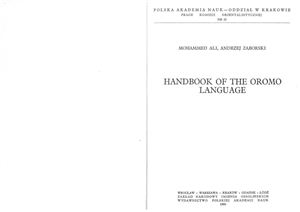Publisher: Polish Academy of Sciences
Publication date: 1990
Number of pages: 174
ISBN: 83-04-03316-X
A textbook of Oromo (Afaan Oromoo), a Cushitic language of Ethiopia with some 25 million speakers.
Oromo (till 1974 known mostly by the now rejected name 'Galla') is one of the major African languages. With its at least 20 million native speakers living in Ethiopia, Northe Kenya and Somalia, Oromo is one of the most widely spoken languages of Africa i.e. after Arabic, Hausa and Swabili. Together with Aharic it is the most important language of Ethiopia where it is used not only as a national language by the Oromo people but also as a lingua franca by several million speakers of other languages. It is a language of a great people with national history going back at least to the 16th century that played since that time a major political and cultUl al role in North-East Africa and whose cultural and social organization (e.g. the famous 'Gada' system) are among the most outstanding in Africa. Spoken on a vast territory ranging from Wello in the North to Northe and even Central Kenya in the South and from Wellegga in the West to Harar in the East, Oromo has several dialects of which the most important and the best known are the dialects of Wcllegga and the Borana, the latter spoken in the South of the Oromo territory. Other dialects are e.g. Tulama, Arsi, Gujji, Raya in Ethiopia, Orma, Munyo and Waata in Kenya. The dialect differences are not big so that interdialect comprehensibility is not a problem. Being related e.g. to Afar-Saho and Somali Oromo belongs to the Cushitic group of languages, and with the whole Cushitic group it belongs to the Afroasiatic or Hamito-Semitic language family together with the Semitic, Berber, Egyptian and Chadic.
Publication date: 1990
Number of pages: 174
ISBN: 83-04-03316-X
A textbook of Oromo (Afaan Oromoo), a Cushitic language of Ethiopia with some 25 million speakers.
Oromo (till 1974 known mostly by the now rejected name 'Galla') is one of the major African languages. With its at least 20 million native speakers living in Ethiopia, Northe Kenya and Somalia, Oromo is one of the most widely spoken languages of Africa i.e. after Arabic, Hausa and Swabili. Together with Aharic it is the most important language of Ethiopia where it is used not only as a national language by the Oromo people but also as a lingua franca by several million speakers of other languages. It is a language of a great people with national history going back at least to the 16th century that played since that time a major political and cultUl al role in North-East Africa and whose cultural and social organization (e.g. the famous 'Gada' system) are among the most outstanding in Africa. Spoken on a vast territory ranging from Wello in the North to Northe and even Central Kenya in the South and from Wellegga in the West to Harar in the East, Oromo has several dialects of which the most important and the best known are the dialects of Wcllegga and the Borana, the latter spoken in the South of the Oromo territory. Other dialects are e.g. Tulama, Arsi, Gujji, Raya in Ethiopia, Orma, Munyo and Waata in Kenya. The dialect differences are not big so that interdialect comprehensibility is not a problem. Being related e.g. to Afar-Saho and Somali Oromo belongs to the Cushitic group of languages, and with the whole Cushitic group it belongs to the Afroasiatic or Hamito-Semitic language family together with the Semitic, Berber, Egyptian and Chadic.

